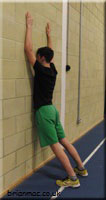

Static Flexibility Test - Ankle
Testing and measurement are the means of collecting information upon which subsequent performance evaluations and decisions are made. In the analysis, we need to consider the factors influencing the results.
Objective
This test aims to monitor the development of the athlete's Ankle flexibility/mobility.
Required Resources
To conduct this test, you will require:
- Flat non-slip surface.
- Wall.
- Ruler.
- Assistant.
How to conduct the test
|
 |
Analysis
Analysis of the test result compares it with the athlete's previous results for this test. It is expected that the analysis would indicate an improvement in the athlete's flexibility with appropriate training between each test. The following link provides various factors influencing the results and therefore, test reliability.
Target Group
These tests are suitable for active individuals but not for those where the test would be contraindicated.
Reliability
Test reliability refers to how a test is consistent and stable in measuring its intended measure. Reliability will depend upon how strictly the test is conducted and the individual's level of motivation to perform the test.
Validity
Test validity refers to the degree to which the test measures what it claims to measure and the extent to which inferences, conclusions, and decisions based on test scores are appropriate and meaningful. This test provides a means to monitor training on the athlete's physical development.
Advantages
- Minimal equipment required
- Simple to set up and conduct
- Can be conducted almost anywhere
Disadvantages
- Assistant required to administer the test
References
- JOHNSON, B.L. and NELSON, J.K. (1986) Practical Measurements for Evaluation in PE. 4th ed. Minneapolis: Burgess Publishing
Page Reference
If you quote information from this page in your work, then the reference for this page is:
- MACKENZIE, B. (2007) Static Flexibility Test - Ankle [WWW] Available from: https://www.brianmac.co.uk/flextest.htm [Accessed